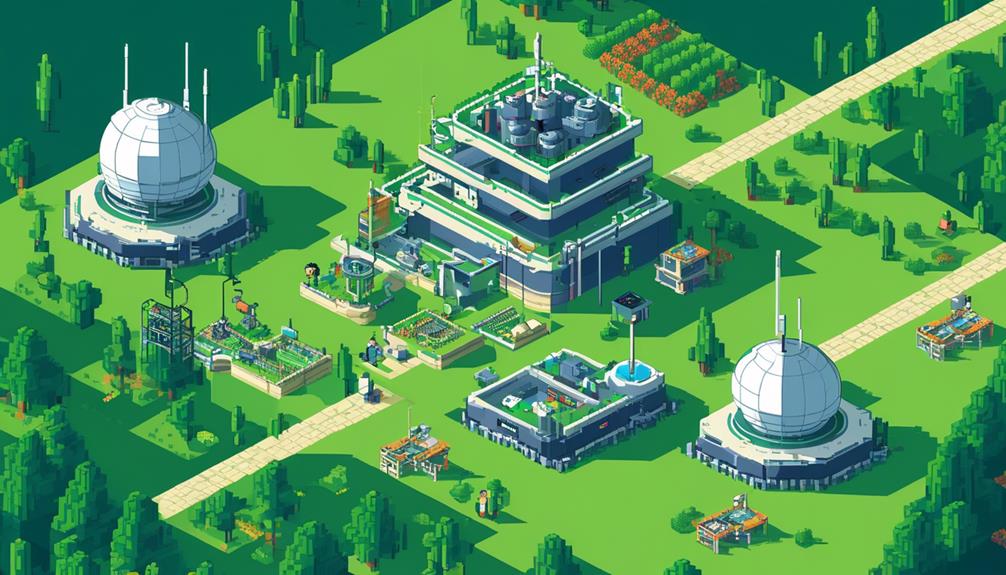Satellite communication hardware is the backbone of modern connectivity, enabling seamless transmission of data, voice, and video signals across vast distances. From satellite dishes to receivers and decoders, modems to transceivers, amplifiers to repeaters, each component plays a critical role in ensuring efficient and reliable communication.
These hardware systems are designed with precision and technical prowess, making them a crucial part of industries such as telecommunications, broadcasting, military, and emergency response. With the constant evolution of technology, satellite communication hardware continues to advance, offering improved performance, flexibility, and cost-effectiveness.
In this discussion, we will explore the various components of satellite communication hardware, their functionalities, and the advancements driving their continuous development.
Key Takeaways
- Satellite dishes, receivers, and decoders are crucial components for reliable satellite communication.
- Signal processing techniques and error correction algorithms enhance signal quality and ensure accurate transmission of data.
- Well-designed modems and high-performance transceivers are essential for efficient data transmission.
- Amplifiers and repeaters strengthen signals and prevent degradation over long distances, maintaining signal integrity.
Satellite Dishes

Satellite dishes, essential for satellite communication and broadcasting purposes, come in various sizes and types, each serving different frequencies and communication needs. These dishes are crucial components of satellite communication systems, enabling the reception and transmission of satellite signals over long distances.
One prominent manufacturer of satellite dishes is Comtech EF Data, known for its wide range of high-performance dishes. They offer parabolic, offset, and prime focus dishes that are designed to meet specific communication requirements. Comtech EF Data's satellite dishes are known for their precise alignment capabilities and efficient signal reception, making them suitable for a variety of applications.
Another notable manufacturer in the industry is CPI Satcom, which specializes in advanced satellite dish systems. Their dishes are engineered to deliver reliable and high-quality satellite communication, even in challenging environmental conditions. CPI Satcom offers a range of dish sizes and types, ensuring that their customers have access to the most suitable solution for their communication needs.
Cross Technologies is yet another provider of satellite dishes, offering a comprehensive portfolio of reliable and high-performance options. Their dishes are designed to provide exceptional signal reception and transmission capabilities, ensuring seamless communication across a wide range of frequencies.
Receivers and Decoders
Receivers and decoders in satellite communication hardware employ advanced signal processing techniques and error correction algorithms to ensure the accurate reception and decoding of satellite signals.
Signal processing techniques enable the extraction of useful information from the received signals, while error correction algorithms correct any errors introduced during transmission.
These features are crucial for achieving reliable and high-quality satellite communication.
Signal Processing Techniques
Signal processing techniques in satellite communication receivers and decoders play a critical role in extracting and interpreting information from satellite signals. These techniques involve demodulation, decoding, error correction, and synchronization to accurately reconstruct the transmitted data.
Advanced algorithms and digital signal processing are employed to enhance signal quality and maximize data throughput. Adaptive equalization and filtering techniques are utilized to mitigate channel impairments and noise in received signals.
Error Correction Algorithms
Error correction algorithms are essential components of satellite communication hardware, ensuring accurate and reliable transmission of data. These algorithms employ error correction techniques and error detection methods to identify and correct errors in received data.
Techniques such as parity checks, checksums, and forward error correction are utilized to detect and correct errors. By implementing these algorithms, satellite communication systems can maintain data integrity and minimize the impact of signal degradation or interference.
Advanced error correction algorithms play a crucial role in ensuring high-quality data transmission over satellite links, especially in challenging environmental conditions. The efficiency of error correction algorithms is vital in enhancing the overall reliability and performance of satellite communication systems.
Through the use of these algorithms, accurate and reliable data transmission can be achieved, enabling seamless communication between satellites and ground stations.
Modems and Transceivers

Modems and transceivers are critical components in satellite communication hardware. They play a pivotal role in ensuring reliable and efficient data transmission.
Modems are responsible for encoding and decoding signals for satellite transmissions. They are responsible for converting digital signals into analog signals that can be transmitted over satellite links. On the receiving end, modems decode the analog signals back into digital format.
Transceivers, on the other hand, enable bidirectional communication with satellites. They have both transmitter and receiver capabilities, allowing them to send and receive data to and from satellites. This bidirectional communication is essential for establishing a reliable connection and exchanging information with satellites.
The functionality of modems and the performance of transceivers are essential considerations for achieving high-quality voice, data, and video transmission in satellite communication systems. A well-designed modem ensures accurate signal encoding and decoding, while a high-performance transceiver enables fast and reliable data transmission.
Modem Functionality
Satellite communication systems rely on the essential components of modems and transceivers to facilitate efficient transmission and reception of data via radio frequency signals over satellite links.
Modems, in particular, play a crucial role in ensuring seamless communication. Modem functionality encompasses various aspects, including troubleshooting, configuration, and compatibility.
Modem troubleshooting involves identifying and resolving issues that may arise during data transmission, such as signal degradation or interference.
Modem configuration refers to the process of setting up the modem according to specific requirements, such as adjusting data rates or configuring encryption protocols.
Modem compatibility is essential to ensure that the modem can operate seamlessly with different satellite communication systems, supporting various frequency bands.
Transceiver Performance
To ensure efficient signal modulation and encoding, the performance of transceivers is crucial in satellite communication systems. Transceiver design plays a significant role in achieving optimal performance. Link budget analysis is conducted to determine the overall system performance, including the expected signal strength and the required receiver sensitivity. This analysis helps in selecting the appropriate transceiver specifications and configurations.
Noise figure optimization is another important aspect of transceiver performance. The noise figure represents the amount of noise added to the received signal during the transmission process. By optimizing the noise figure, the signal-to-noise ratio can be improved, leading to better overall system performance.
Manufacturers like Comtech EF Data, GD Satcom Technologies, iDirect, Newtec, and Foxcom offer advanced transceiver solutions that provide high stability RF frequency converters, DVB-S and DVB-S2 satellite modulators, and fiber optic IFL systems for enhanced signal transmission and reception in satellite communication systems.
Amplifiers and Repeaters
Amplifiers and repeaters are essential components in satellite communication systems, as they strengthen and propagate signals over long distances, ensuring reliable and uninterrupted communication. These devices play a crucial role in enhancing the reach and quality of satellite communications. Here are some key aspects to consider when it comes to amplifiers and repeaters:
- Amplifier efficiency: Amplifiers are responsible for boosting the strength of weak signals, increasing the overall signal power. It is important to consider the efficiency of amplifiers to ensure minimal signal loss and optimal performance. High-efficiency amplifiers help maximize the power transfer, minimizing power wastage and reducing system costs.
- Repeater placement: Repeaters are used to regenerate and retransmit signals, extending the coverage area of satellite communication networks. Proper placement of repeaters is critical to ensure seamless signal transmission. Careful consideration must be given to factors such as line-of-sight obstruction, signal attenuation, and the distance between repeaters to maintain signal integrity and prevent signal degradation.
- Signal integrity troubleshooting: In satellite communication systems, maintaining signal integrity is of utmost importance. Amplifiers and repeaters can introduce noise and distortions to the signal. Regular monitoring and troubleshooting of signal quality parameters such as signal-to-noise ratio, bit error rate, and signal strength are necessary to identify and rectify any issues that may arise.
Antenna Tracking Systems
With the amplifiers and repeaters ensuring reliable signal propagation, the next crucial component in satellite communication hardware is the antenna tracking system. These systems are essential for ensuring optimal signal reception by automatically aligning satellite antennas with the satellite's position in the sky. They incorporate motorized mounts and control systems that continuously track the satellite's movement, compensating for the Earth's rotation and maintaining a stable connection.
Antenna Tracking Systems are particularly important for mobile satellite communication applications, such as maritime, broadcasting, and military operations. In these scenarios, the antenna's orientation needs to be constantly adjusted as the satellite moves across the sky. The motorized mounts enable precise and smooth movement, keeping the antenna pointed towards the satellite at all times.
These systems can be integrated with various satellite communication hardware, including VSAT terminals and flyaway antennas. By combining the antenna tracking system with these devices, seamless and reliable connectivity can be achieved, even in challenging environments.
One of the primary purposes of Antenna Tracking Systems is to ensure uninterrupted data, voice, and video services. By accurately tracking the satellite's position, these systems maintain a strong and stable connection, minimizing signal interference and dropouts.
Power Supplies and Backup Systems
Power supplies and backup systems play a crucial role in ensuring uninterrupted operation of satellite communication hardware. Here are some important facts about configuring power supplies, power outage management, and remote monitoring and control:
- Configuring power supplies: Proper sizing and configuration of power supplies is essential to meet the specific power requirements of satellite communication equipment. This involves determining the appropriate voltage levels, current ratings, and power capacity to ensure reliable operation.
- Power outage management: Power outages can disrupt satellite communication services and result in significant downtime. Backup systems, such as uninterruptible power supplies (UPS), are used to provide temporary power during outages. These systems utilize batteries or generators to supply electricity until the main power source is restored.
- Remote monitoring and control: Advanced power supply units often feature remote monitoring and management capabilities. This enables operators to monitor the status of power supplies and backup systems from a central location. Remote control functionality allows for efficient troubleshooting and maintenance, minimizing the need for onsite visits.
Ground Stations and Control Centers

Ground stations and control centers are essential facilities that facilitate communication with satellites and ensure the smooth operation of satellite networks. Equipped with antennas, receivers, and transmitters, ground stations establish a vital link between the satellite and the Earth's surface. They are responsible for tracking and controlling the satellite's orbit, managing data transmission, and monitoring overall satellite health.
Control centers, often located at ground stations, serve as the command and control hub for satellite operations. They play a crucial role in managing multiple satellites and coordinating their activities. Control centers employ sophisticated satellite communication protocols and network management systems to ensure efficient and secure communication between the ground station and the satellite. These protocols define the rules and procedures for exchanging data and commands between the two entities, enabling seamless communication and control.
One of the primary responsibilities of ground stations and control centers is satellite interference mitigation. Satellite interference can occur due to various factors, such as signal jamming or unintentional interference from other satellite systems. To mitigate interference, ground stations implement advanced monitoring and detection systems that identify and locate the source of interference. Once identified, appropriate measures are taken to minimize the impact and restore normal communication.
Satellite Communication Software
Satellite communication software plays a crucial role in managing and optimizing satellite communication systems, enabling efficient utilization of resources and ensuring reliable data transmission. Here are some key points regarding satellite communication software:
- Network Optimization:
Satellite communication software provides tools for optimizing network configuration and performance. It offers features for monitoring and managing satellite terminals, antennas, and network performance. By analyzing network data and making adjustments, the software helps to enhance operational efficiency and reliability.
- Data Transmission:
Satellite communication software includes modulators, demodulators, and signal processing algorithms for encoding and decoding data transmitted over satellite links. These software solutions support various protocols and standards for satellite communication, such as DVB-S, DVB-S2, and MF-TDMA. This ensures compatibility with different satellite communication equipment and facilitates seamless data transmission.
- Bandwidth Management:
Efficient bandwidth management is crucial in satellite communication to maximize the utilization of available resources. Satellite communication software provides tools for bandwidth allocation, traffic prioritization, and bandwidth optimization. By intelligently managing bandwidth, the software helps to minimize congestion and ensure smooth data transmission.
Frequently Asked Questions
What Are the Devices Used in Satellite Communication?
Satellite communication relies on various devices to ensure efficient transmission and reception. Key components include:
- Satellite antennas: There are different types of satellite antennas, such as parabolic, phased array, and helical antennas. These antennas are responsible for receiving and transmitting signals between the satellite and the ground stations.
- Satellite modems: Satellite modems are used for signal modulation and encoding. They convert the digital signals from the ground stations into a format suitable for transmission over satellite links, and vice versa.
- Satellite transceivers: Satellite transceivers enable bidirectional communication between the satellite and ground stations. They receive signals from the ground stations, amplify them, and retransmit them back to the ground stations.
These devices play a crucial role in establishing and maintaining reliable satellite communication networks. They facilitate the transmission of data, voice, and video signals over long distances.
What Are the 3 Types of Satellite Communication?
There are three types of satellite communication networks based on the types of satellite orbits:
- Geostationary (GEO) satellites are positioned at a fixed point above the Earth's equator. They provide continuous coverage to a specific region. GEO satellites are commonly used for telecommunication and broadcasting applications. They offer a high data rate and are ideal for services that require constant connectivity.
- Low Earth orbit (LEO) satellites orbit closer to the Earth, at altitudes ranging from a few hundred to a few thousand kilometers. LEO satellites offer lower latency and higher data rates compared to GEO satellites. This makes them suitable for applications that require real-time communication, such as mobile and broadband communication. LEO satellites are also used for remote sensing applications, such as Earth observation and climate monitoring.
- Medium Earth orbit (MEO) satellites orbit at intermediate altitudes between GEO and LEO satellites. They provide a balance between coverage and latency. MEO satellites are commonly used for navigation and communication services, such as GPS (Global Positioning System). These satellites offer improved accuracy and coverage compared to LEO satellites.
These satellite communication networks are utilized for various applications, including telecommunication, broadcasting, navigation, and remote sensing. They play a crucial role in enabling global connectivity and facilitating communication in remote areas.
What Is a Satellite Communication Device?
A satellite communication device refers to any hardware equipment or system used to facilitate the transmission and reception of data, voice, and video signals through satellite networks. These devices employ various satellite communication protocols to establish reliable connectivity over long distances.
They offer numerous advantages, including global coverage, high bandwidth capacity, and the ability to operate in remote and challenging environments. Satellite communication devices find applications in areas such as telecommunications, broadcasting, military operations, maritime and aviation industries, and disaster management.
What Types of Equipment Is Needed on All Satellites?
Antenna systems, transponders, and power systems are essential equipment found on all satellites.
Antenna systems play a crucial role in collecting and radiating electromagnetic waves, enabling communication with ground stations.
Transponders receive, amplify, and retransmit signals, ensuring their strength and quality during satellite communication.
Power systems provide the necessary electrical power to operate all the satellite's components and systems.
These equipment are fundamental for the successful operation of satellites and facilitating reliable satellite communication.
